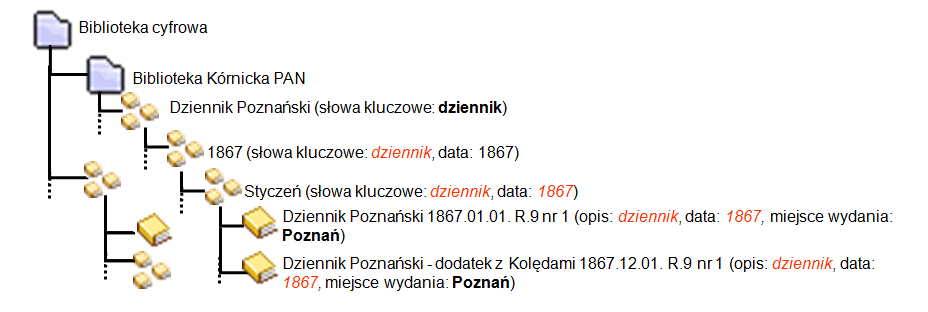Introduction
The mechanism of grouping related digital objects in the dLibra system is based on so-called group publications. Grouping related objects is used for, among other items, newspapers, journals, or multi-volume publications. Its result are complex objects – group publications (for example, a publication which groups all numbers of a newspaper from a given year). The structure of group publications is hierarchical, so more complex structures which group related objects can be created. On the website of a digital library, the reader can see a group publication and easily navigate its structure. It is also possible to determine the order of particular objects in a group publication.
Group Publication Properties
In the dLibra system, group publications also play an additional role: they can be ascribed certain properties. There are two kinds of those properties: properties related only to the group publication and inherited properties (which, if present, are automatically passed on to the grouped elements). The inherited properties are: descriptive metadata, assignment to a collection, and access permissions for a publication. The group publication-specific properties are: group publication name and group publication thumbnail.
Group publication properties – not inherited
When editors create a group publication, they can enter the following properties, related only to a group publication:
- name – the name of the group publication, displayed on a web page when the structure of the group publication is presented, and
- thumbnail – a pictogram which represents the group publication, for example, a newspaper logo.
Group publication properties – inherited
The inherited properties of a group publication are: descriptive metadata, assignment to a collection, and access permissions for a publication. The mechanism of inheriting group publication properties in the dLibra system accelerates editors’ work because some properties can be introduced only once, at the group publication level, and then automatically inherited by the elements in the group. In the subsequent chapters, we present examples of inheriting particular properties.
Inheriting Access Permissions for a Publication
In the dLibra system, editors can assign three permissions for a publication: access to published editions (browsing), access to all editions (reading), and management (the permissions system is described here). The image below shows a sample structure of a group publication called “Dziennik poznański”.
Jak widać Dziennik poznański jest publikacją grupową (obiektem złożonym) w którym znajduje się kolejna publikacja grupowa 1867. W publikacji grupowej 1867 znajdują się publikacje grupowe odpowiednie miesiącom rocznika 1867 (np. styczeń). W poszczególnych publikacjach grupowych odpowiadających miesiącom znajdują się konkretne obiekty cyfrowe z treścią (publikacje). I tak do publikacji grupowej Dziennik poznański użytkownik adam ma przypisane prawo przeglądanie podobnie jak grupa Użytkownicy publiczni (Użytkownicy publiczni to specjalna grupa w systemie dLibra, która identyfikuje wszystkich użytkowników niezalogowanych i tych posiadających konto założone samodzielnie poprzez strony internetowe). Dzięki mechanizmowi dziedziczenia do publikacji grupowej 1867, która znajduje się w publikacji grupowej Dziennik poznański, użytkownik adam i grupa Użytkownicy publiczni mają dziedziczone prawo przegladanie. Dodatkowo, na poziomie publikacji grupowej 1867 użytkownikowi adam przydzielono prawo odczyt. Poprzez mechanizm dziedziczenia użytkownik adam ma dziedziczone prawo przegladanie i odczyt do publikacji grupowej Styczeń (grupa Użytkownicy publiczni dziedziczy bez zmian prawo przegladanie). Publikacje zwykłe znajdujące się w publikacji grupowej Styczeń dziedziczą odpowiednie prawa z wszystkich nadrzędnych publikacji, przy czym oczywiście możliwe jest dodatkowe przyznanie praw odpowiednim użytkownikom (jak ma to miejsce dla użytkownika adam w przypadku publikacji Dziennik poznański 1867.01.01. R.9 nr 1 - przyznane dodatkowe prawo zarządzanie).
Dziedziczenie przypisania publikacji do kolekcji
Poniżej przedstawiono rysunek prezentujący przykładowe wykorzystanie mechanizmu dziedziczenia przypisań publikacji do kolekcji.
Jak widać na rysunku powyżej publikacja grupowa Dziennik poznański przypisana jest do kolekcji Materiały regionalne. Przypisanie dziedziczone jest w całej strukturze publikacji (dziedziczą to publikacje grupowe 1867 oraz Styczeń jak i wszystkie publikacje zwykłe). Poza tym, na każdym poziomie możliwe jest przypisanie publikacji do dodatkowej kolekcji tak jak ma to miejsce w przypadku publikacji Dziennik poznański - dodatek z Kolędami 1867.12.01. R.9 nr 1, która przypisana jest jeszcze do kolekcji Muzykalia.
Dziedziczenie metadanych opisowych publikacji grupowej
The image below presents a sample use of the mechanism of inheriting descriptive metadata.
The image above shows inheriting metadata in the structure of a group publication. Like in the earlier cases, that mechanism causes particular elements of metadata to be inherited by the publications in a group publication. As we can see, the value of attribute “key words” is passed on to all publications in the “Dziennik poznański” group publication. Additionally, in the “1867” group publication, value “1867” is ascribed to the date attribute, and that assignment is also inherited by publications lying deeper in the structure.


